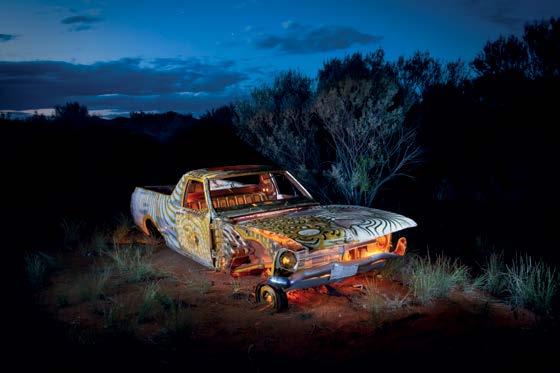

Ki n a r a pu l ka irnya n i palya n u. Tji nt ungku kampara uti n u.
[The big moon shone brightly and made. The sun burnt through and brought it out.]
Robert Fielding traces the cycles of day and night across the chassis of abandoned cars, or the frames of forgotten bicycles. These traces hold a rhythmic cadence where speech and text flow and unfold, ardent like the glowing sun.
Reading Fielding’s poetic exhibition title is like watching him speak, our eyes search out the words, transfixed by their elusive, esoteric meanings. Considered as a curatorial refrain, Fielding’s title is an invocation that resonates with the Perth Festival theme – in Noongar language, Ngaangk, “the ultimate creator – rising, surely each morning at dawn to break the still darkness of night”.¹ The works in this exhibition each uniquely evoke the cyclical play between the Sun and Moon, the great drivers of life, culture, language and Country.
A contemporary artist of Pakistani, Afghan, Western Arrente and Yankunytjatjara descent, and currently living in Mimili community on APY lands, Fielding wields a range of mediums, tools and stories with elastic, deeply lived and cyclical devotion. As a recurring theme, Fielding bears the history of objects he finds across Mimili, recontextualising the cycles of life and death: eating, moving, playing and sleeping. The found objects that feature in the series of photographs Objects of Origin (2018) and the accompanying video work Cycles (2018) are significant to the Mimili community. Bicycles hold a history of prestige, and prams carried new generations. Flour buckets, once holding rations of flour, tea, sugar or tobacco are repurposed as stools or legs for a bed. Collectively such objects speak to the love, loss and community of Mimili that holds and sustains its members. Fielding is deeply committed to his people, Country and culture, there is no separation between his life and art.
In our language we say Ngapartji-Ngapartji: A process of doing things together, side by side. To give to one another, to share.²
¹ Alta Winmar with Roma Yibiyung Winmar, Perth Festival 2024 Program. ² https://www.agsa.sa.gov.au/whats-on/tarnanthi/tarnanthi-2023/tarnanthi -robert-fielding-keynote-address/, retrieved 11/01/2024. ³ https://nga.gov.au/publications/ceremony/robert-fielding, retrieved 11/01/2024.
Manta Miil-miilpa (2022) is a collection of photograms in which Fielding records the interplay between language and landscape. A dance between artist and Country, the paper accumulates marks and an aura of colour that evokes the eternal presence of Tjukurpa and his ancestors’ spirits. On top of these ephemeral frottages, Fielding photographs the landscape using a UV sensitive dye to expose the image onto the paper, and the traces of variable natural elements are recorded. To finish the works, the exposures are washed in the water of the land and left to dry.
Graveyards in Between (2017) details the encounter and transformative gestures Fielding undertakes with found cars: the trace of past Mimili Elders. Onto the bonnets, doors, hubcaps and roofs of the cars, Fielding inscribes the patterns of the Anangu people: codes that hold sacred cultural knowledge. In the video that accompanies his series of nine photographs, Fielding reverently walks around each of the cars, studying their form. Dots and lines expand outwards in response to existing physical characteristics: rust, dents, bullet holes. The shape and design of each car provide starting points for these performative collaborations.
Noted as culturally significant objects in 2019, large numbers of the car wrecks have nonetheless been removed to make way for sweeping infrastructure and road upgrades, without community consultation. Fielding’s ongoing project/action part functions as a memorial, highlighting “the long and ongoing list of injustices inflicted on our people and on our land”.³ The cars offer potent symbols of travel, family, colonial infrastructure, waste, and decay. In collaboration with such symbols, Fielding attends and renews these graveyards with a deep respect for their history, and for what kinds of futures they point toward.
Fielding's practice demonstrates reciprocity, and in doing so, gathers ideas, stories and histories on labour, renewal, encounter, transformation, childhood, language and Country. From the earliest dawn, the most sunbaked midday, to the calmest twilight and deepest night.
Paul Boyé & Lia McKnight
